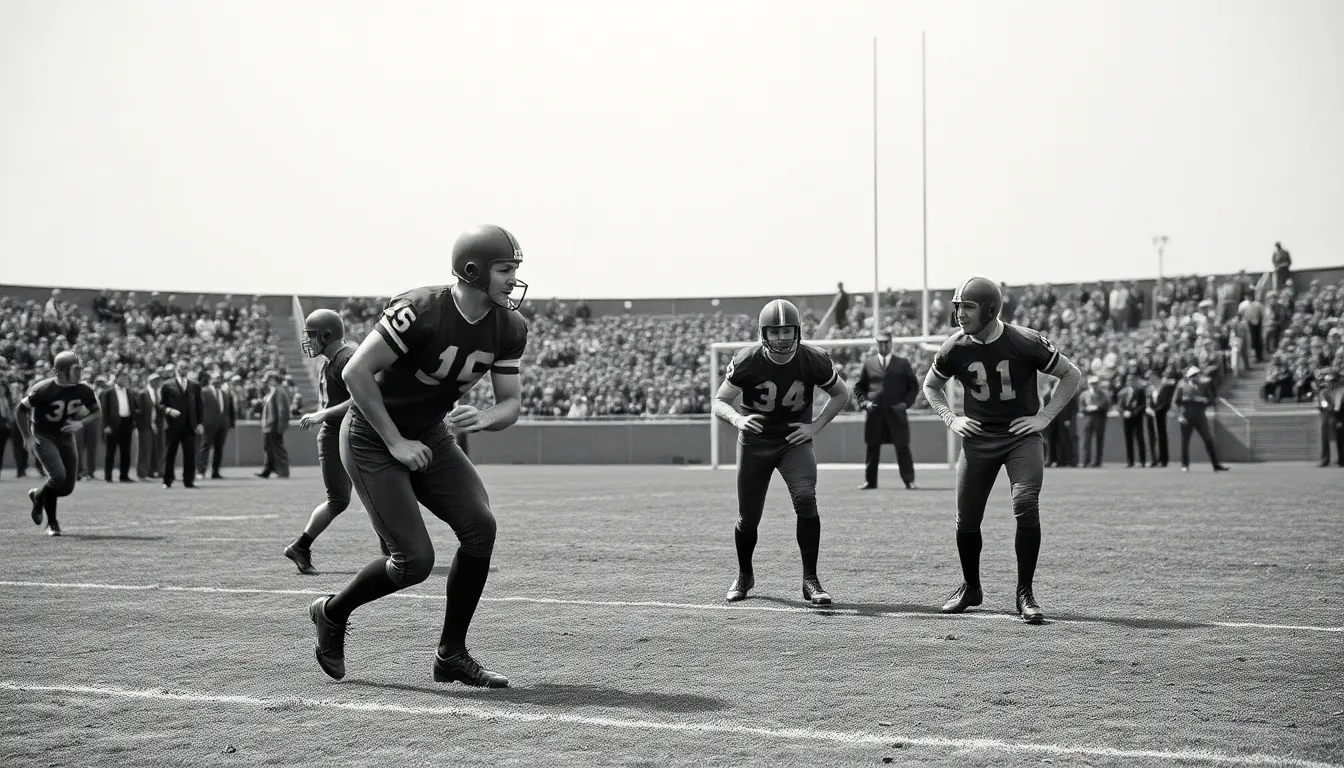When it comes to American sports, nothing quite compares to the thrill of NFL football. Picture this: a crisp autumn day, the smell of popcorn wafting through the air, and friends gathered around the TV, all wearing their team jerseys like a badge of honor. It’s not just a game; it’s a cultural phenomenon that unites fans across the nation, igniting rivalries and sparking unforgettable moments.
From jaw-dropping touchdowns to nail-biting fourth-quarter comebacks, NFL football serves up drama that keeps fans on the edge of their seats. Whether you’re a die-hard supporter or a casual viewer, the excitement is contagious. So, grab your favorite snacks and settle in, because this season promises to deliver more than just big hits and flashy plays—it’s a rollercoaster ride of emotions that’ll have you laughing, cheering, and maybe even crying (just a little).
NFL Football
NFL football represents one of the most popular professional sports leagues in the United States. With 32 teams, the National Football League showcases a mix of athletic talent and strategic gameplay, captivating millions of fans each season. Each Sunday, fans gather in stadiums and homes across the country, creating an electric atmosphere filled with excitement and energy.
Regular season games consist of 17 games for each team, leading to a competitive playoff format. Fans eagerly track team standings and player statistics, which can influence everything from fantasy football leagues to betting decisions. The postseason culminates in the Super Bowl, a cultural event watched by over 100 million viewers, highlighting the league’s prominence in American society.
NFL football emphasizes teamwork, discipline, and physical prowess. Coaches devise complex strategies to exploit opponents’ weaknesses while players execute plays that demand precision and speed. Notable players often become iconic figures, with many achieving legendary status due to their remarkable performances and contributions to the game.
Moreover, the league addresses social issues through initiatives like Player Coalition, promoting equality and diversity. NFL football isn’t solely about competition; it also serves as a platform for important conversations. With an engaging mix of on-field action and off-field impact, the NFL continues to shape American sports culture, forging connections that extend beyond the game.
History Of NFL Football

NFL football has a rich history filled with transformative moments and key developments. Understanding its journey reveals how the sport became an integral part of American culture.
Early Beginnings
The NFL traces its origins to the formation of the American Professional Football Association in 1920, which later became the NFL in 1922. Early teams faced challenges related to organization and competition, with only 14 franchises in the inaugural season. The introduction of the forward pass changed gameplay dynamics, making the sport more exciting and unpredictable. In 1933, the NFL introduced the Championship Game, a significant step in establishing a formal competition structure. Significant tensions arose as rival leagues, such as the All-America Football Conference, emerged, ultimately pushing the NFL to adapt and strengthen its brand.
Major Milestones
Key events marked the NFL’s evolution into a premier sports league. The 1958 NFL Championship Game significantly increased the league’s visibility, often referred to as the “Greatest Game Ever Played.” Through the 1960s and 1970s, the league expanded, thanks to strategic mergers and innovative television contracts. The merger with the American Football League in 1970 established the groundwork for today’s modern NFL. The introduction of the Super Bowl in 1967 laid the foundation for what would become an annual cultural phenomenon. Player safety reforms, including rules around helmets and tackling, emerged in response to growing concerns over injuries, underscoring the league’s commitment to player welfare.
Rules Of NFL Football
Understanding the rules of NFL football enhances the viewing experience. The game involves precise strategies, and knowing them can deepen appreciation for the sport.
Basic Gameplay
NFL football features two teams competing over four quarters, each lasting 15 minutes. The objective centers on advancing the ball down the field to score points. Players can advance by running with the ball or throwing it to teammates. A team has four downs to gain at least ten yards. If they achieve this, they receive a new set of downs. Timing plays a critical role; the game clock stops for certain situations, such as incomplete passes and timeouts. The field itself measures 100 yards in length, with end zones extending 10 yards deep at each end.
Scoring System
The scoring system in NFL football promotes excitement and strategy. A touchdown, worth six points, occurs when a player crosses the opponent’s goal line with the ball. After a touchdown, teams can attempt an extra point kick for one additional point or a two-point conversion by running or passing the ball into the end zone again. A field goal, scoring three points, happens when a team successfully kicks the ball through the opponent’s goalposts. Safeties, worth two points, can occur when the defense tackles an offensive player in the offense’s own end zone. Collectively, these methods create dynamic scoring opportunities throughout the game.
Teams And Players
NFL football features a diverse array of teams and standout players that shape the league’s dynamics. Each team embodies unique strengths and fan bases.
Notable Teams
The New England Patriots hold a prominent place in NFL history, boasting multiple Super Bowl victories. Another powerhouse, the Pittsburgh Steelers, shares a legacy of success, with a record number of championships to their name. The Green Bay Packers, known for their rich history and passionate fans, remain a symbol of tradition within the league. Likewise, the Kansas City Chiefs have gained attention in recent years with their explosive offense and strong playoff performances. Each team brings its own cultural significance, fan loyalty, and playoff ambitions, contributing to the competitive landscape of NFL football.
Key Players
Tom Brady, regarded as one of the greatest quarterbacks, fundamentally changed how football is played with his remarkable skill and decision-making. Patrick Mahomes, the Chiefs’ dynamic quarterback, redefined modern offense with his unique play style and extraordinary athleticism. Aaron Rodgers of the Packers demonstrates exceptional precision and football intellect, earning numerous accolades throughout his career. Additionally, Derrick Henry, the running back for the Tennessee Titans, showcases remarkable power and speed, consistently dominating defensive fronts. These players exemplify the talent and charisma that elevates the NFL, captivating audiences and inspiring future generations.
NFL Football Culture
NFL football embodies a vibrant culture, merging passion, excitement, and community. The game nurtures deep connections among fans, creating an atmosphere of camaraderie.
Fan Engagement
Fan engagement thrives through various channels, encompassing social media interactions and community events. Many supporters gather in stadiums, hosting tailgates that enhance the game day experience. This socialization fosters a strong bond among fans, heightening their emotional investment in the teams. Personalized merchandise and fantasy football leagues also deepen fan ties, allowing supporters to feel like active participants. Celebrations for victories and shared heartbreak after defeats contribute to collective experiences that define NFL culture.
Media Coverage
Media coverage plays a pivotal role in shaping NFL football’s cultural narrative. Major networks dedicate extensive resources to broadcasting games, ensuring millions tune in weekly. Highlight shows and analysis programs enhance viewers’ understanding, showcasing strategic elements and player performances. Online platforms amplify discussions through podcasts and articles, creating interactive fan experiences. With social media, instant updates and live commentary keep audiences engaged and connected, fueling the ongoing discourse surrounding teams and players.
Conclusion
NFL football stands as a cornerstone of American culture uniting fans through shared passion and excitement. The game transcends mere competition becoming a vibrant community experience filled with unforgettable moments and emotional highs. As teams battle for supremacy every season the league continues to evolve while maintaining its rich history and tradition.
The strategic depth of the game combined with the athletic prowess of its players keeps audiences captivated. With ongoing discussions about player safety and social initiatives the NFL also reflects broader societal values. Whether through thrilling matchups or the camaraderie built among fans the essence of NFL football remains a powerful force in the landscape of sports.

